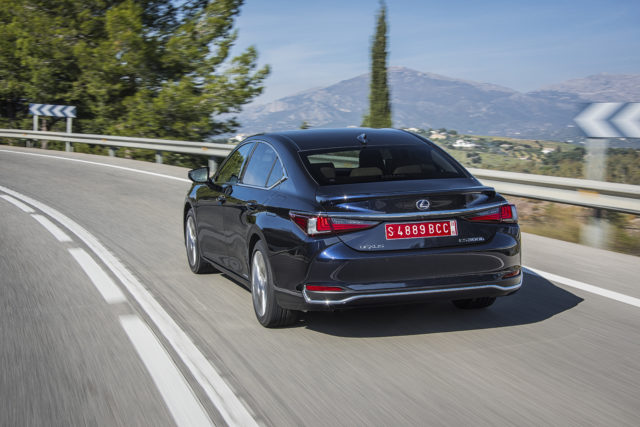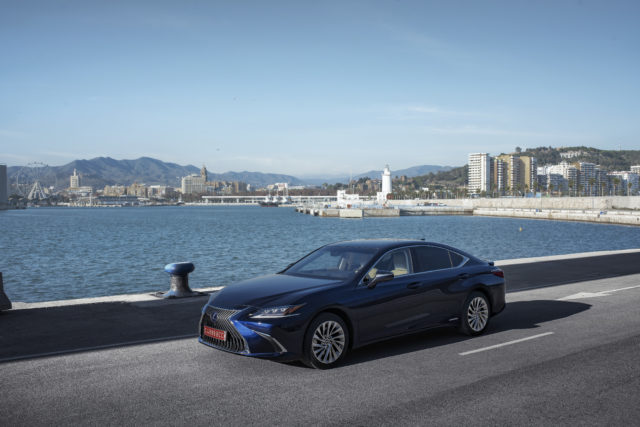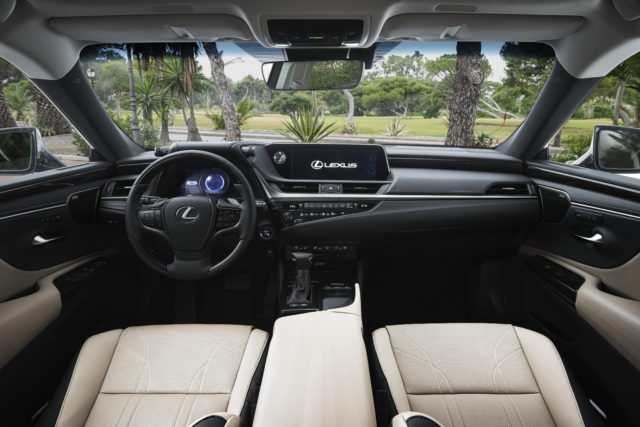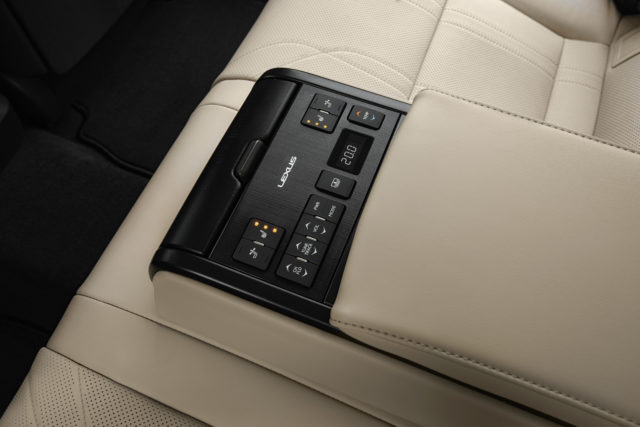
What is it?
ES is a nameplate steeped in history for Lexus — but one many here in the UK are unlikely to of heard of before.
Roll the years back to 1989, and to the launch of the Lexus brand globally. The ES was one of two cars tasked with allowing this new Japanese firm to take on traditional premium rivals — and its success has seen it now enter its seventh-generation.
Despite that, this is the first iteration of the executive saloon coming to the UK — replacing the slow-selling GS. Is it enough for Lexus to find success in a segment so traditionally dominated by the Germans?

What’s new?
The ES is both new to the UK, and totally new in this form. It’s set upon the GA-K (Global Architecture-K) platform, which will also see action as host of the latest Toyota Camry further on into 2019.
There are some brand firsts for Lexus here too, with a new 2.5-litre petrol engine featuring as part of an overhauled hybrid system, while new safety assistance technologies back up the forward-thinking approach here.
It’s also the first time Lexus has had a real go at making its trendy F Sport grade distinguishable from the rest of the range here. How? Having got behind the wheel of it, we’ll come to that…
New year, new Lexus ES pic.twitter.com/BWTmYHCpYW
— Ryan Hirons (@RyHirons) January 9, 2019
What’s under the bonnet?
Here in the UK, we’ll only see the ES in 300h form — meaning it’s powered by a 2.5-litre petrol-electric hybrid powertrain, capable of developing a combined 215bhp while torque is rated at 221Nm for the internal combustion engine and 202Nm for the electric motor. The system is paired with a CVT gearbox.
As a result, 0-60mph comes in 8.7 seconds with a top speed of 112mph possible. Lexus claims the ES300h can achieve 53mpg on the combined cycle while emitting 106g/km of CO2 emissions.
In a move that’s to be expected of Lexus at this point, the system is well-refined and just simply does the job. There’s not an abundance of power, but enough for it to accelerate briskly to motorway speeds and sit there quietly thanks to its electric capabilities. That said, the old CVT trick of making an engine sound like a vacuum cleaner while getting up to speed is all too present.

What’s it like to drive?
Buyers of a Lexus ES will likely do most of their driving on a motorway, and it excels here. Lexus has worked hard to ensure it’s a quiet and comfortable thing at speed (they say 93 per cent of the hidden metal is covered in soundproofing material), and it has paid off.
It rides exceptionally well and there’s so little noise coming into the cabin that you could probably hear a baby breathing while hurtling along at 70mph.
Don’t expect the excitement to ramp up when things get twisty though — despite the F Sport’s attempts to bring that to the table. What sets this model apart is trick adaptive suspension that, in simple terms, aims to bring a more involved drive when pressing on while creating a more comfortable environment at a cruise. It does the latter well, but there’s little sense of involvement under harder loads.

How does it look?
Unmistakably Lexus is the best way to describe the looks of the ES. It manages to be reserved yet bold at the same time, largely thanks to the gargantuan spindle grille sitting at the front of the car.
F Sport variants get a model-specific take on that grille, boasting a honeycomb pattern in favour of the lined unit found on other trims. On top of that, it also boasts 19-inch alloy wheels, jet black exterior highlights, tweaked bumper designs and a subtle boot lid spoiler.
The F Sport package doesn’t make the ES look over-styled to our eyes, but those who want the ‘sporty’ option in the range to stand out might be left wanting for more.

What’s it like inside?
Cabin quality is of a seriously high standard in the Lexus ES. Plush materials are present on every visible and touchable surface in the cabin, while an abundance of leather ensures the seats and steering wheel match the impression of quality.
That said, the driving position almost feels like an afterthought — it’s slightly offset from a natural position to the pedals and pushed almost into the door.
Lexus also claims best-in-class distance between the back of the rear seats to that of the front passenger. That’s an elaborate way to say it’s pretty spacious for those in the back too, offering bags of legroom for even taller adults. As for boot space, the ES offers 454 litres.

What’s the spec like?
Pricing for the Lexus ES begins at £35,150, with standard-fit equipment including adaptive cruise control, automatic LED headlights, front and rear parking sensors, heated electric seats, a reversing camera, rear privacy glass plus the Lexus Navigation infotainment system displayed on an eight-inch touchscreen (and sadly still linked to a dodgy trackpad).
On top of that, upgrading to F Sport brings with it the previously mentioned styling tweaks and suspension upgrades, plus unique seats and power folding mirrors. The F Sport is available from £38,150.
Those wanting a little more luxury over the standard car can opt for the £45,650 Takumi trim — bringing with it 18-inch alloy wheels, blind spot monitoring, an automatic boot, a 10-inch head-up display and a larger 12.3-inch infotainment screen.

Verdict
While the Lexus ES300h remains its only variant, it’s not going to be knocking the established German rivals from the perch — but the Japanese firm will be the first to tell you it isn’t aiming to do that.
Rather, this is an alternative for those who want hybrid efficiency and strong quality yet have residual values and low running costs strong in the back of their minds. It helps the car itself is pretty good too — offering bags of luxury and tech in a comfortable package.
Alternatively-fuelled cars remain the niche choice, but perhaps it’s fair to say the Lexus ES is well positioned to be a seriously strong executive contender when the majority become plugged into the electric revolution.

Enjoy the convenience of having The Sunday Post delivered as a digital ePaper straight to your smartphone, tablet or computer.
Subscribe for only £5.49 a month and enjoy all the benefits of the printed paper as a digital replica.
Subscribe